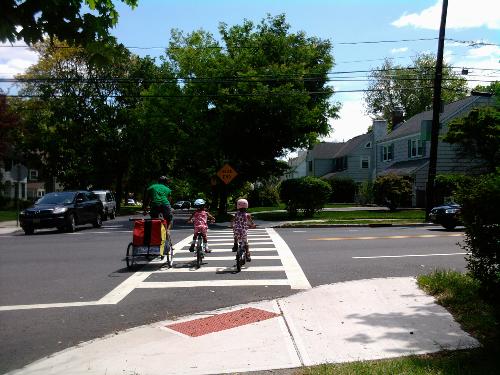Yes, traffic fatalities have been (mostly) going down, but as long as cyclist and pedestrian fatalities keep going up, we can’t truly say our streets and roads are getting safer. That’s the message from 68 members of Congress to one pretty receptive audience: Transportation Secretary Ray LaHood.

In their letter to LaHood, sent on Saturday, the 68 lawmakers – including nine Republicans -- note that between 2010 and 2011, driving got safer: Roadway fatalities dropped 2 percent overall; 4.6 percent for occupants of cars and light trucks. But bicyclist fatalists went up 9 percent and pedestrian deaths rose 3 percent in the same time period.
LaHood announced earlier this month that U.S. DOT would be holding two bike safety summits this year. But the lawmakers want the agency to go further. And they didn’t just ask in vague terms for increased attention to safety. They got specific: U.S. DOT should create “separate performance measures for non-motorized and motorized users.”
If it sounds like they might have gotten some ideas from people deep inside the bike advocacy world, well, you got that right. Hundreds of Bike Summit participants made this their key “ask” earlier this month when they visited their representatives on Capitol Hill. Apparently their representatives listened.
SAFETEA-LU, passed in 2005, required states to set goals for reducing overall fatalities but included no specific reporting requirements for biking and walking. Without state attention, vulnerable road users have become even more vulnerable, with fatalities increasing both in real numbers and as a percentage of roadway fatalities, according to Caron Whitaker of the League of American Bicyclists.
One-third of the House Transportation and Infrastructure Committee signed on to the letter, giving DOT a good sense how the committee wants them to interpret MAP-21. “When Congress set performance measures areas, they were saying, ‘These are the things we are going to judge you on,’” Whitaker said in an email. “If bicyclists and pedestrians aren't included in the performance measures, we risk being left behind.”
“In over half of all states, more than 10 percent of roadway fatalities are bicyclists and pedestrians but yet only seven states report investing in any bicycling and walking safety projects,” she added.
The lawmakers' letter notes that MAP-21 required U.S. DOT to set performance measures for safety and increase safety funding to states. The signers hope that by setting specific metrics for bike and pedestrian safety, DOT can incentivize states to reduce fatalities, “while giving them the flexibility to choose the best methods to do so.”
Could increased focus on reducing bike and pedestrian fatalities lead states to limit or dis-incentivize bicycling? They might (incorrectly) assume that fewer people on bikes means fewer people dying on bikes. Whitaker says Metropolitan Planning Organizations will see to it that the performance measures aren’t interpreted that way, and if for some reason a state did use the focus on safety as an excuse to limit biking, they’d be hearing from activists – and mayors, and community leaders – pretty quickly.
They also note that such a measure wouldn’t divert funding from other safety needs.
The timing of the letter is good. U.S. DOT is still working on drafting MAP-21 performance measures, and the agency is paying special attention to bicycle safety this month.





